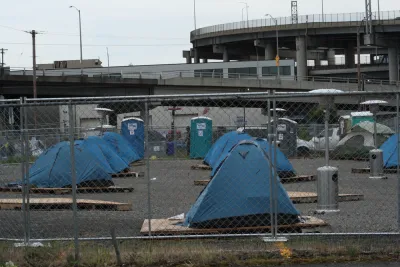Both West Coast cities are preparing to criminalize sleeping on public streets, claiming new shelter beds will provide enough resources for their unhoused populations.

In a housing brief on Next City, Roshan Abraham outlines two proposals aimed at further criminalizing homelessness in Portland, Oregon and Sacramento. The two cities are poised to ban sleeping on public streets if two proposals are approved by Portland’s city council and Sacramento voters.
The Portland proposal calls for increased shelter capacity and would force unsheltered people to move to city-run “alternate camping sites,” which would accommodate roughly 1,500 people, around half of the city’s unhoused population. “Oregon Live reports that the city council supports the resolutions, but getting them passed would not automatically lead to a camping ban or new shelter space, as resolutions are non-binding and the funding details would have to be worked out in the next budget cycle.”
In Sacramento, a ballot measure will let voters decide whether to make camping on public streets a misdemeanor. “The measure also allows “any resident harmed” by a violation of the measure to begin proceedings with the city to have someone removed.” If the measure passes, it may not be enforceable due to a clause that requires cooperation with the county.
Critics say cities are engaging in “legal gymnastics” to leverage new shelter space as “a pretext for criminalization,” with Abraham noting that “many cities rush to roll out shelter space prior to camping bans in order to comply with the 2019 decision in Martin vs. Boise, which barred jurisdictions from issuing public sleeping bans when there was not sufficient shelter space.”
FULL STORY: Housing In Brief: Portland & Sacramento Propose Citywide Camping Bans

National Parks Layoffs Will Cause Communities to Lose Billions
Thousands of essential park workers were laid off this week, just before the busy spring break season.

Retro-silient?: America’s First “Eco-burb,” The Woodlands Turns 50
A master-planned community north of Houston offers lessons on green infrastructure and resilient design, but falls short of its founder’s lofty affordability and walkability goals.

Delivering for America Plan Will Downgrade Mail Service in at Least 49.5 Percent of Zip Codes
Republican and Democrat lawmakers criticize the plan for its disproportionate negative impact on rural communities.

Test News Post 1
This is a summary

Test News Headline 46
Test for the image on the front page.

Balancing Bombs and Butterflies: How the National Guard Protects a Rare Species
The National Guard at Fort Indiantown Gap uses GIS technology and land management strategies to balance military training with conservation efforts, ensuring the survival of the rare eastern regal fritillary butterfly.
Urban Design for Planners 1: Software Tools
This six-course series explores essential urban design concepts using open source software and equips planners with the tools they need to participate fully in the urban design process.
Planning for Universal Design
Learn the tools for implementing Universal Design in planning regulations.
EMC Planning Group, Inc.
Planetizen
Planetizen
Mpact (formerly Rail~Volution)
Great Falls Development Authority, Inc.
HUDs Office of Policy Development and Research
NYU Wagner Graduate School of Public Service





























